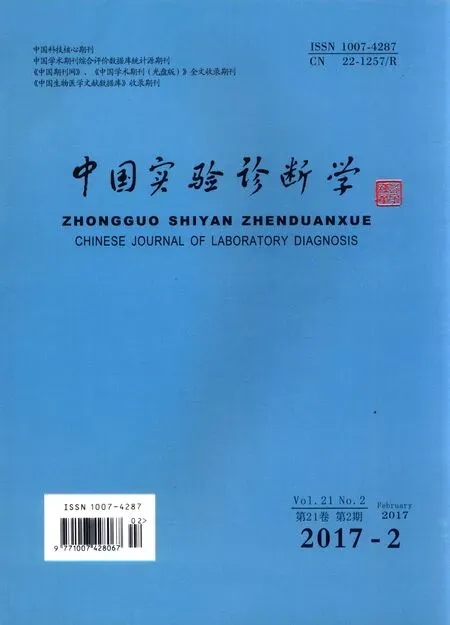肺大细胞神经内分泌癌的诊疗进展
2017-03-04付义林
付义林,佟 倜
(吉林大学第二医院 胸外科,吉林 长春130041)
*通讯作者
肺大细胞神经内分泌癌的诊疗进展
付义林,佟 倜*
(吉林大学第二医院 胸外科,吉林 长春130041)
最新版的世界卫生组织 (World Health Organization,WHO) 2015年肺癌病理分类将小细胞肺癌(SCLC)、类癌(typical carcinoid,TC)及肺大细胞神经内分泌癌(LCNEC)共同归类于神经内分泌肿瘤[1],这也为今后肺LCNEC的诊疗指明了新的道路。肺大细胞神经内分泌癌(LCNEC)约占肺癌病例的2.1%-3.5%[2],然而随着组织学诊断技术的进步,尤其是免疫组化神经内分泌标志物的发展,越来越多的肺部神经内分泌肿瘤得以诊断并分型,这也是近年来肺部神经内分泌肿瘤发病率不断增高的原因之一[4],其真实发病率通常高于预计值。肺LCNEC的高危因素通常包括:男性,高龄(中位年龄为65周岁),吸烟史[5]。
1 临床表现
肺LCNEC与恶性肿瘤一样通常都表现出侵袭性的生物学行为[6]。肺LCNEC初期的患者一般无明显症状,咳嗽、咳痰、咯血、阻塞性肺炎较少见[7],部分患者可有无痛性淋巴结肿大及胸痛,无特异性的流感样症状、呼吸困难、盗汗,副癌综合征较少见[8]。因此在确诊时,肺LCENC的患者淋巴结转移率高((60%-80%)、远处转移率高(40%)[9,10],与小细胞肺癌相似(表1)。
2 术前检查诊断方法
胸部CT(computed tomography,CT)通常作为首选检查,肺LCNEC在CT上通常呈周围型扩张性生长、边缘不规则的肺部肿块,有分叶征、毛刺征及胸膜牵拉征[11],与扩张性生长的周围型SCLC、低分化腺癌、鳞癌等类似,极少数为纵膈型[12]。约有10%的病例伴有部分钙化[13],大量淋巴结肿大的情况较少见。因此术前单纯从胸部CT区分LCNEC与其他肺部恶性肿瘤的难度较大。
痰液脱落细胞学检查阳性率通常较低[14]。若病灶位置适宜,支气管镜检查及病变组织活检可作为确诊的进一步检查[15],但应同时考虑到纤维支气管镜活检受标本大小、组织形态等因素的影响较大,使得LCNEC 术前的诊断率低。
神经内分泌肿瘤中生长激素抑制素受体(SSTR)表达率高[16],近年来SSTR显像诊断技术已被用于术前诊断。肺LCNEC的诊断通常需要免疫组织化学染色及超微显微镜下确定神经内分泌分化的明显标志,在没有大量活体组织标本时或术前诊断LCNEC相当困难。
因此精准的病理学诊断在肺LCNEC的诊疗过程中是必不可少的一个环节,是下一步的诊疗计划的基础。国际肺癌研究联合会(International Association for the Study of Lung Cancer)建议应用TNM(tumor,node,metastasis)分期预测神经内分泌肿瘤的预后[17]。

表1 肺LCNEC的主要临床病理学特征
3 病理学特征
肺LCNEC呈浸润性生长,细胞病理学特征包括:细胞体积大;有丰富的坏死组织;低核/质比(细胞核大,核仁明显);细胞呈巢状排列;神经内分泌肿瘤常见的形态学特征如器官样,栅样,花瓣样或小梁状的细胞生长排列方式[18];超微结构上常见少量腺样或鳞状的分化。(表1)。
腺癌细胞或鳞癌细胞有时共同存在于这些肿瘤中,我们将这些肺LCNEC命名为“混合神经内分泌癌[19](mixed LCNEC)”。尽管前瞻性的数据具有不确定性,但现有数据表明混合肺LCNEC患者5年生存率(overall survival ,OS)约为30%[20],与单纯肺LCNEC患者5年生存率类似。
LCNEC与AC(非典型类癌,atypical carcinoids ,AC)具备某些共同的病理学特征,如生长模式及细胞坏死,因此鉴别诊断对病理科医生是一项挑战。例如,AC有丝分裂少见,LCNEC坏死细胞更为常见,>11/10高倍镜(HP)的有丝分裂率(表2)是LCNEC和SCLC不同于AC的关键。
4 免疫组化及分子标记物
在诊断非小细胞肺癌时,通常使用免疫组织化学标记。鳞状标记包括细胞角蛋白(CK)5/6,蛋白(p)63,和p40[21]。腺癌标记包括甲状腺转录因子-1,napsin A,和CK7[22]。而神经内分泌癌标记物包括嗜铬素A(chromogranin A)、突触素(synaptophysin)、CD56[23],其中至少有 1 种以上表达阳性。最新数据显示,相对于非神经内分泌肿瘤(non—LCNECs)和小细胞肺癌(SCLC),LCNEC在免疫组化中表达更高水平的原肌球相关激酶B(tropomyosin-related kinase B)和脑源性神经因子[24](brain-derived neurotrophic factor),这为进一步区分LCNEC与其他肺脏内分泌源性肿瘤提供了良好的依据。
5 SCLC与肺LCNEC的鉴别诊断
SCLC与肺LCNEC的共同点表现在:男性吸烟者高发,细胞高有丝分裂率,表达多种神经内分泌细胞标记物,恶性度高,预后差,存在基因突变[25](如MEN1基因突变)。这也使得这两种组织分型均归属到 “高度恶性神经内分泌肿瘤(high-grade neuroendocrine carcinoma ,HGNEC)”中。
精确的病理学细胞形态区分可以很好的为两者划清界限[26]:(表 2)

表2 SCLC与肺LCNEC鉴别诊断要点
6 预后及生存率
肺LCNEC与SCLC表现出类似的生物学侵袭性。两者的生存曲线随时间进展逐步重叠,其生存率远低于其他非小细胞肺癌[27],即使在术后Ⅰ期肺LCNEC的患者中,5年生存率仍约为33%。
7 治疗及联合治疗方案
因其发病率较低,临床工作中少见,随机临床试验很难进行,现阶段尚未形成肺LCNEC的治疗标准[28]。尽管我们对确诊Ⅰ期的肺LCNEC患者尽早行手术治疗,对进展期的患者采取多种方案联合治疗,其5年生存率仍然很低。
对于肿瘤分期处于TNMⅠ—Ⅱ期的患者,手术治疗应作为第一首选,同时这也是肺LCNEC患者确诊的主要方法[29]。在纵隔淋巴结系统采样中,肺叶切除或者全肺切除的患者可有效减少淋巴结转移途径,提高术后生存率[30],因此推荐肺叶切除或者全肺切除作为手术患者的第一选择。(表1)
Grand等人[31]在一项回顾性数据分析中比较了肺LCNEC与大细胞癌(large cell carcinoma,LCC)的诊疗结果,就手术方式(病灶局部切除、肺叶切除、全肺切除)而言,没有明显证据表明其与术后整体存活率明显相关。
Mazières等人[32]报道了一宗18个肺LCENC患者的病例,这些病人先接受了根治性的外科手术治疗,随后实验者对T3和/或 N2的病人进行辅助放疗。这些病人的一年生存率约为27%,并且与淋巴结转移与否无明显关联。
手术治疗的确使约30%的患者收益[33],因此,完善围手术期在提升整体治疗效果方面显得尤为重要[34]。
所有可手术切除的肺LCNEC患者(TNM Ⅰ—Ⅲ期)均应尽早行手术治疗[35]。新辅助化疗、辅助化疗可作为防止肿瘤复发的有效手段[36]。在一项对144例肺LCNEC患者的回顾性分析中,Ⅰ期患者行术前或术后化疗获得了更好的治疗效果,表明在LCNEC的早期阶段联合治疗不可忽视[37]。
2006年,Iyoda等人[38]依据SCLC患者的化疗方案,对肺LCNEC患者进行了以“铂类+依托泊苷”为化疗方案治疗的前瞻性研究。与对照组同等状况的患者相比,实验组明显受益,5年生存率实验组vs.对照组为88.9% vs.47.4%,2年无病生存率约为86.7% vs.47.8% 。随着后期临床试验证明,以“铂类+依托泊苷”为基础的联合化疗对疾病的治疗及预后起到了至关重要的效果,推荐为一线化疗用药。而以“铂类+氨柔比星”的二线化疗方案同样也在回顾性临床试验中表明有效[39]。
放疗对肺LCNEC患者的治疗效果尚未明确,一些学者认为对病灶局限、进展期或不适宜手术的患者可试行放疗[40]。大量的SCLC患者在化疗后得以部分或者完全缓解,而后行预防性放射治疗,这一方法尚不推荐对肺LCNEC患者进行[41]。
[1]Morena Fasano,MD,PhD,et al.Pulmonary Large-Cell Neuroendocrine Carcinoma From Epidemiology to Therapy[J].Journal of Thoracic Oncology,2015,10(8):1133.
[2]Fasano M,Della Corte CM,Papaccio F,et al.Pulmonary large-cell neuroendocrine carcinoma[J].J Thorac Oncol,2015,10(8):1133.
[3]Travis WD,Brambilla E,Burke AP,et al.WHO classification of tumors of the lung,pleura,thymus and heart.4th ed[J].International Agency for Research on Cancer,2015:63.
[4]Sun JM,Ahn MJ,Ahn JS,et al.Chemotherapy for pulmonary large cell neuroendocrine carcinoma:similar to that for small cell lung cancer or non-small cell lung cancer[J]?Lung Cancer,2012,77(2):365.
[5]Niho S,Kenmotsu H,Sekine I,et al.Combination chemotherapy with irinotecan and cisplatin for large-cell neuroendocrine carcinoma of the lung:a multicenter phase II study[J].J Thorac Oncol,2013,8(7):980.
[6]De Pas TM,Giovannini M,Manzotti M,et al.Large-cell neuroendocrine carcinoma of the lung harboring EGFR mutation and responding to gefitinib[J].J Clin Oncol,2011,29(34):e819.
[7]Edge SB,Byrd DR,Compton CC,et al.AJCC Cancer Staging[J].Manual,2010,30(50)110.
[8]Wolfson AH,Bae K,Komaki R,et al.Primary analysis of a phase II randomized trial Radiation Therapy Oncology Group (RTOG) 0212:impact of different total doses and schedules of prophylactic cranial irradiation on chronic neurotoxicity and quality of life for patients with limited-disease small-cell lung cancer.International journal of radiation oncology[J].biology,physics,2011,81:77.
[9]Sánchez de Cos Escuín J.Diagnosis and treatment of neuroendocrine lung tumors[J].Arch Bronconeumol,2014,50:392.
[10]Foster NR,Qi Y,Shi Q,et al.Tumor response and progression-free survival as potential surrogate endpoints for overall survival in extensive stage small-cell lung cancer:findings on the basis of North Central Cancer Treatment Group trials[J].Cancer,2011,117:1265.
[11]Kinoshita T,Yoshida J,Ishii G,Aokage K,Hishida T,Nagai K;The differences of biological behavior based on the clinicopathological data between resectable large-cell neuroendocrine carcinoma and small-cell lung carcinoma[J].Clin Lung Cancer,2013,14:535.
[12]Sun J-M,Ahn M-J,Ahn JS,Um S-W,Kim H,Kim HK et al;Chemotherapy for pulmonary large cell neuroendocrine carcinoma:similar to that for small cell lung cancer or non-small cell lung cancer? Lung Cancer,2013,77:365-370.
[13]Hiroshima K,Iyoda A,Shida T,et al.Distinction of pulmonary large cell neuroendocrine carcinoma from small cell lung carcinoma:a morphological,immunohistochemical,and molecular analysis[J].Mod Pathol,2006,19:1358.
[14]International Agency for Research on Cancer In:Travis WD,Bambilla E,Burke AP,Marx A,Nicholson A,eds.WHO Classification of Tumours of the Lung,Pleura,Thymus and Heart[J].Geneva:WHO Press,2015,132:131.
[15]Rekhtman N,Marchetti A,Lau C,et al.Analysis of EGFR and KRAS Mutations in Small Cell Carcinoma and Large Cell Neuroendocrine Carcinoma of Lung.IASLC 14th World Conference on Lung Cancer[R].Amsterdam,The Netherlands,2011.
[16]Rivera MP,Mehta AC.Initial diagnosis of lung cancer.ACCP evidence-based clinical practice guidelines (2nd edition)[J].Chest,2007,132:131.
[17]Kaira K,Murakami H,Endo M,et al.Biological correlation of 18FFDG uptake on PET in pulmonary neuroendocrine tumors[J].Anticancer Res,2013,33:4219.
[18]Leverson JD,Zhang H,Chen J,et al.Potent and selective small-molecule MCL-1 inhibitors demonstrate on-target cancer cell killing activity as single agents and in combination with ABT-263 (navitoclax)[J].Cell Death Dis,2015,6:e1590.
[19]Sarkaria IS,Iyoda A,Roh MS,et al.Neoadjuvant and adjuvant chemotherapy in resecate pulmonary large cell neuroendocrine carcinomas:a single institution experience[J].Ann Thorac Surg,2011,92:1180.
[20]Tanaka Y,Ogawa H,Uchino K,et al.Immunohistochemical studies of pulmonary large cell neuroendocrine carcinoma:a possible association between staining patterns with neuroendocrine markers and tumor response to chemotherapy[J].J Thorac Cardiovasc Surg,2013,145:839.
[21]Burger JA and Peled A.CXCR4 antagonists:targeting the microenvironment in leukemia and other cancers[J].Leukemia,2009,23:43.
[22]Zhang B,Wu T,Wang Z,et al.p38MAPK activation mediates tumor necrosis factor-alpha-induced apoptosis in glioma cells[J].Molecular medicine reports,2015,11:3101.
[23]Kaemmerer D,Reimann C,Specht E,et al.Differential expression and prognostic value of the chemokine receptor CXCR4 in bronchopulmonary neuroendocrine neoplasms[J].Oncotarget,2015,6:3346.
[24]Swarts DR,Ramaekers FC and Speel EJ.Molecular and cellular biology of neuroendocrine lung tumors:evidence for separate biological entities[J].Biochim Biophys Acta,2012,1826:255.
[25]Gridelli C,Rossi A,Airoma G,et al.Treatment of pulmonary neuroendocrine tumours:state of the art and future developments[J].Cancer Treat Rev,2013,39:466.
[26]Kim YJ,Hwang SJ,Bae YC,et al.MiR-21 regulates adipogenic differentiation through the modulation of TGF-beta signaling in mesenchymal stem cells derived from human adipose tissue[J].Stem Cells,2009,27,3093.
[27]Lee HW,Ha SY,Roh MS.Altered expression of PTEN and its major regulator microRNA-21 in pulmonary neuroendocrine tumors[J].Korean J.Pathol,2014,48,17.
[28]Guan P,Yin Z,Li X,et al.Meta-analysis of human lung cancer microRNA expression profiling studies comparing cancer tissues with normal tissues[J].J.Exp.Clin.Cancer Res,2012,31,54.
[29]Cai MY,Zhang B,He WP,et al.Decreased expression of PinX1 protein is correlated with tumor development and is a new independent poor prognostic factor in ovarian carcinoma[J].Cancer Sci,2010,101(6):1543.
[30]Travis WD.Pathology and diagnosis of neuroendocrine tumors:lung neuroendocrine[J].Thorac Surg Clin,2014,24(3):257.
[31]Grand B,Cazes A,Mordant P,et al.High grade neuroendocrine lung tumors:pathological characteristics,surgical management and prognostic implications[J].Lung Cancer,2013,81:405.
[32]Mazières J,Daste G,Molinier L,et al.Large cell neuroendocrine carcinoma of the lung:pathological study and clinical outcome of 18 resected cases[J].Lung Cancer,2002,37:290.
[33]Fournel L,Falcoz PE,Alifano M,et al.Surgical management of pulmonary large cell neuroendocrine carcinomas:a 10-year experience[J].Eur J Cardiothorac Surg,2013,43:110.
[34]Saji H,Tsuboi M,Matsubayashi J,et al.Clinical response of large cell neuroendocrine carcinoma of the lung to perioperative adjuvant chemotherapy[J].Anticancer Drugs,2010,21:89.
[35]Zhang P,Zou M,Wen X,et al.Development of serum parameters panels for the early detection of pancreatic cancer[J].Int J Cancer,2014,134(11):2646.
[36]Fiala O,Pesek M,Finek J,et al.The role of neuron-specific enolase (NSE) and thymidine kinase (TK) levels in prediction of efficacy of EGFR-TKIs in patients with advanced-stage NSCLC [corrected][J].Anticancer Res,2014,34(9):5193.
[37]Kenmotsu H,Niho S,Ito T,et al.A pilot study of adjuvant chemotherapy with irinotecan and cisplatin for completely resected highgrade pulmonary neuroendocrine carcinoma (large cell neuroendocrine carcinoma and small cell lung cancer)[J].Lung Cancer,2014,84:254.
[38]Iyoda A,Makino T,Koezuka S,et al.Treatment options for patients with large cell neuroendocrine carcinoma of the lung[J].Gen Thorac Cardiovasc Surg,2014,62:350.
[39]Yanagisawa S,Morikawa N,Kimura Y,et al.Large-cell neuroendocrine carcinoma w ith EGFR mutation:possible transformation of lung adenocarcinoma[J].Respirology,2012,17(8):1275.
[40]Sarkaria IS,Iyoda A,Roh MS,et al.Neoadjuvant and adjuvant chemotherapy in resected pulmonary large cell neuroendocrine carcinomas:a single institution experience [J].Ann Thorac Surg,2011,92(4):1180.
[41]Kenmotsu Y,Oshita F,Sugiura M,et al.Nedaplatin and irinotecan in patients with large-cell neuroendocrine carcinoma of the lung[J].Anticancer Res,2012,32(4):1453.
1007-4287(2017)02-0351-04
2016-03-26)
